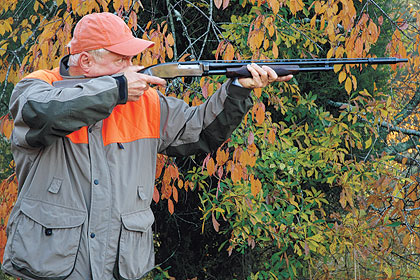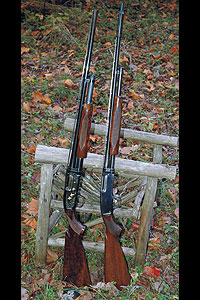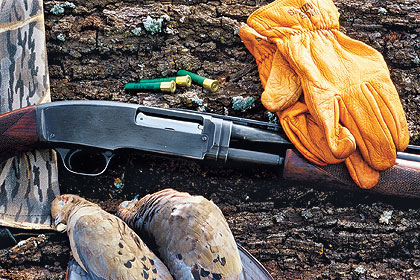By Layne Simpson
Several years ago I came up with the idea of having a casual clay target tournament with a different twist at my gun club. Guns that could be used in the "Old Timers Skeet Shoot" (as I promoted it) were restricted to slide actions and side-by-side doubles.
 The author's Model 42 is the Skeet grade with 2½ inch chamber, ventilated rib and Cutts Compensator. |
To make it even more challenging, I imposed the low-gun start position, which was required in American skeet before gamesters came along and spoiled it by changing the rules to allow the gun to be shouldered prior to calling for a target. What had been a game for hunters became an endurance test for target shooters who had absolutely no interest in hunting.
At any rate, our vintage gun shoot proved to be great fun and what interested me most was the variety of old scatterguns that got pulled from the back of the closet and dusted off for a day in the sun. Like me, many of the members of our club shoot clay targets mainly to keep the old eye sharp for wingshooting and our group was well represented.
In the .410 event, I was one of several who shot a Winchester Model 42. I had purchased mine sometime back from a Baptist preacher who lived in North Carolina and had been an avid skeet shooter during the 1940s and on into the 1950s. His other three guns were Winchester Model 12s in 28, 20 and 12 gauges but unfortunately for me, those had already sold before I got to the sale.
I was surprised at the number of Model 42s that showed up for my vintage gun shoot but I was not surprised by the fact that several other hunters and skeet shooters owned them.
In my neck of the woods the .410 has long been popular among quail and dove hunters and of the various guns that have been chambered for it, the Model 42 used to be one of the more popular. Anyone who has dropped a quail with one will tell you why at the drop of a hat.
When the Model 42 was introduced in 1933 the slide action was the most popular type of repeating shotgun.
And of all the companies building pump guns, Winchester was the clear leader, first with its Model 1897 and then beginning in 1912 with the Model 12.
The Model 12 had sold well for a number of reasons, one being the fact that it was available in 12, 16, 20 and 28 gauges. In addition to being a favorite among hunters, it was also one of the most popular guns used in the rapidly growing sport of skeet shooting. In skeet, where the different gauges are contested separately, competitors prefer to shoot the same type of gun in all events and this presented a problem for Winchester's sales force since the Model 12 was not available in .410.
They probably could have done it but choosing not to do so resulted in one of the all time classics in shotguns of American design. Although the two differ in minor design details the Model 42 looks a lot like a scaled-down version of the Model 12. Weights will vary a bit from gun to gun, but the Model 42 is usually about a pound lighter than the 20-gauge Model 12 and 11„2 pounds lighter than that gun in 12 gauge.
In those days the game of skeet did not have as many followers as today so Winchester officials knew that in order for the Model 42 to become a commercial success it would have to sell to hunters as well. At the time, 21„2 inches was the longest .410 shell produced and its shot charge weighed only 3„8 ounce. Maximum shot charge weight for the 28 gauge was 3„4 ounce so Winchester made the decision to develop a three-inch version of the .410 with the same amount of shot.
 The Model 42 at right looks a lot like a scaled-down version of the Model 12 at left. |
William Roemer, who was chief design engineer at Winchester at the time, was assigned the job of designing the Model 42 and he was obviously an efficient fellow because the new shotgun was ready for production about a year ahead of schedule. But its production was delayed until 1933.
The three-inch .410 shotshell was a pet project of John Olin, who, in addition to being president of the company, was an avid bird hunter and he insisted that the Model 42 and the new three-inch shell be introduced together.
The Model 42 became an instant success with clay target shooters and went on to not only dominate the .410 class but win its share of shoots against the 28 gauge as well. One of its biggest accomplishments came in 1934 when it was used to win the Florida Any Gauge Individual Championship against other shooters who were using guns in all gauges including the 12. Still, John Olin's prediction held true--a lot more Model 42s were eventually sold to hunters than to skeet shooters.
Winchester advertisements of the 1930s described the Model 42 as "The Greatest Little Shotgun in the World" and went on to extol its virtues not only as ideal for shooting doves, quail, woodcock and pheasant but just the ticket as a family gun to be enjoyed by Mom, Dad and all the kids. Carrying on with that theme, a special "Family Package" consisting of a Model 42, a hand trap and a box of clay targets was offered for $34 and it contained a brochure describing how everyone could enjoy fun-filled weekends at less cost than a Saturday matinee.
But most of Winchester's promotional dollars were spent in convincing grown-up hunters that life would not be complete without a Model 42 and included such descriptive comments as "lighter weight, less recoil, faster handling, less muzzle blast and less fatiguing to carry." They also played up the cost factor. It is different now but from the 1930s on into the 1950s .410 shells were less expensive than the larger gauges and when the Model 42 was introduced in 1933 a box of three-inch shells for it sold for 88 cents compared to $1.21 for a box of 12 gauge shells.
During its first year of production the Model 42 was offered only in field and skeet grades with 26- and 28-inch barrels, and choke constrictions were limited to Cylinder, Skeet, Modified and Full. Those first barrels were plain but in 1934 a solid matted rib was offered as an option. Many years later (1954) Winchester added a ventilated rib to its list of Model 42 options and since it proved to be more popular than the original solid rib, the latter was dropped in 1959.
The gun was initially available only with a three-inch chamber but skeet shooters who shot the 21„2 inch shell in competition were of the opinion that t
he Model 42 would shoot more uniform patterns if it had a 21„2 inch chamber so that option was added in 1935. (It may have been true back in the 1930s but today's 21„2 inch shell delivers patterns of equal quality when fired in 3-inch and 21„2 inch chambers).
During the early years of skeet, the Cutts Compensator with its interchangeable choke tubes enjoyed some popularity among competitors so in 1934 Winchester offered that factory-installed option on the Model 42. Guns could also be returned to Winchester for installation of the Cutts and there is an easy way to tell one from the other.
If a Model 42 was originally shipped from the factory wearing one, its barrel will have no choke marking. If a gun was returned for retrofitting, its barrel will have the choke marking. Contrary to the expectations of Winchester, the Cutts Compensator did not prove to be a popular option among skeet shooters and for this reason guns that wear one are among the rarest of Model 42s.
 The Model 42 used to be quite popular among quail and dove hunters. |
The Model 42 I own and love to hunt with is a Skeet grade with 21„2 inch chamber and was built in 1953. It has the Cutts Compensator and when I bought it its previous owner could locate only its Spreader and Full choke tubes. I find the Spreader choke a bit too open for shots on doves and quail much beyond 20 yards while the Full choke is too tight.
Choke tubes in the larger gauges are not too difficult to locate but despite years of searching I have been unable to turn up Improved Cylinder and Modified for my gun.
During its production years a number of Model 42 variations were offered by Winchester with Skeet and Standard the most common. It is easy to identify the grade of a gun by looking at its wood. The Skeet grade will have checkering on its stock and forearm whereas the Standard grade (or field grade as it is commonly called) will have no checkering and its forearm will have gripping grooves.
If the forearm of a gun has 18 grooves it was built prior to World War II while 14 grooves indicate post-war production. The checkering on Skeet-grade guns built prior to the war will have 20 lines to the inch while guns built after the war wear 18-line checkering. Both grades of guns were available with either straight or curved grip buttstock and while the former was mildly popular among skeet shooters most hunters preferred the latter.
A number of exhibition grade Model 42s with fancy wood and highly engraved metal were also produced, some bringing thousands of dollars at a time when a dollar really was worth a dollar. Examples are a cased pair built for President Dwight Eisenhower and presented to him by his bird-hunting buddy, Alton Jones, who was Chairman of the Board of Cities Service Oil Company at the time. Jones owned a quail plantation in Georgia and he and Eisenhower hunted there quite often.
Also quite rare is a Pigeon Grade gun special-ordered by actor Robert Taylor and completed in 1946. Soon after marrying Ursula Thiess in 1954, Taylor returned the gun to Winchester and had a gold nameplate with her initials engraved into its stock.
But most Model 42s were bought by average citizens, many of whom probably had to save up their spare coins for quite a while before buying one. And Winchester did its best to keep the little gun affordable. Despite the fact that the hand-fitting of some of its parts made the Model 42 one of the more expensive firearms for Winchester to produce, its retail price was only $101.85 when it was discontinued in 1963. Around 160,000 were built.
Regardless of whether you are a pump gun fan or not, the Model 42 has to be considered one of the finest shotguns designed and built in America. It can also be addictive. Anyone who can pick up one without immediately falling head over heels in love either has a heart of stone or doesn't know what the perfect woodcock gun feels like.
If the Winchester Model 12 is the "Perfect Repeater" as it was once described by Winchester, then the Model 42 is, without doubt, "The Shotgunner's Sweetheart."






